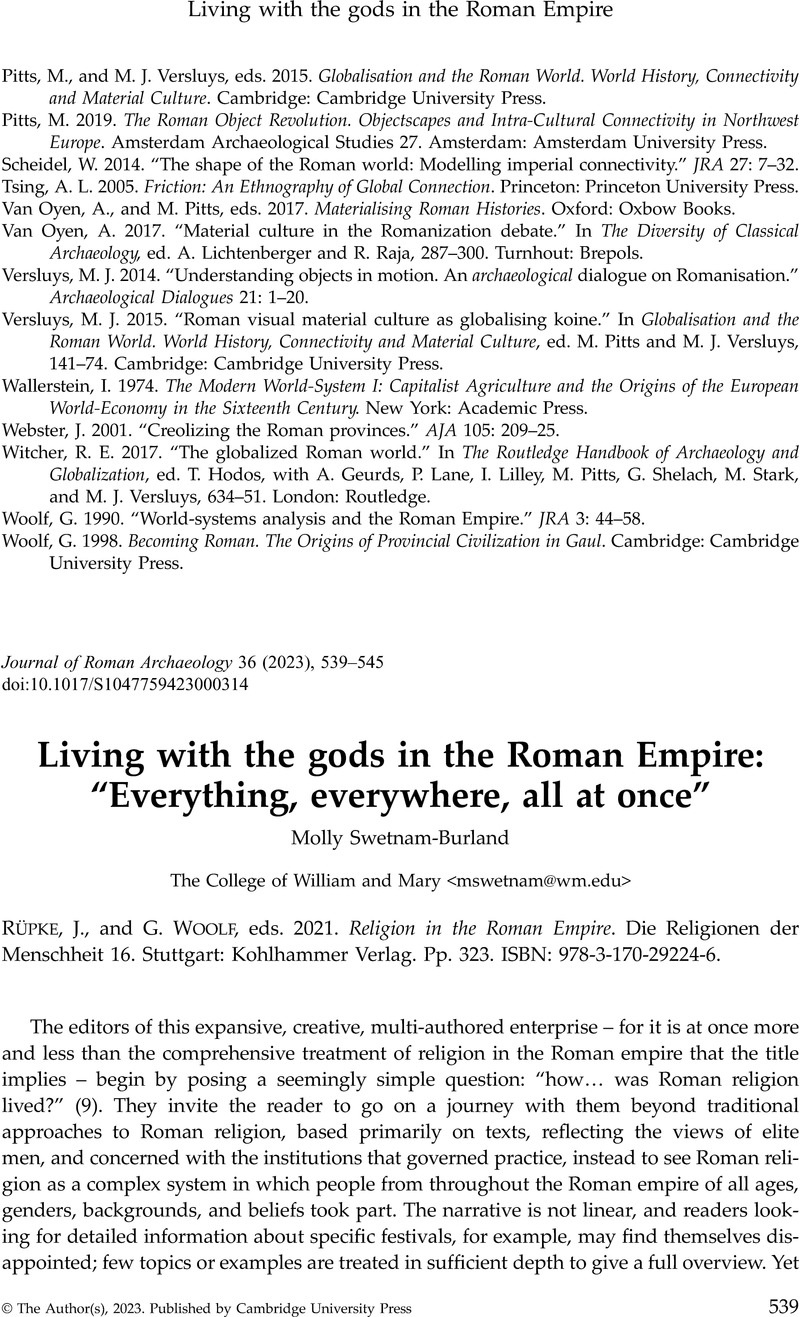No CrossRef data available.
Article contents
Living with the gods in the Roman Empire: “Everything, everywhere, all at once” - J. Rüpke, and G. Woolf, eds. 2021. Religion in the Roman Empire. Die Religionen der Menschheit 16. Stuttgart: Kohlhammer Verlag. Pp. 323. ISBN: 978-3-170-29224-6.
Review products
J. Rüpke, and G. Woolf, eds. 2021. Religion in the Roman Empire. Die Religionen der Menschheit 16. Stuttgart: Kohlhammer Verlag. Pp. 323. ISBN: 978-3-170-29224-6.
Published online by Cambridge University Press: 17 August 2023
Abstract
An abstract is not available for this content so a preview has been provided. Please use the Get access link above for information on how to access this content.

- Type
- Book Review
- Information
- Copyright
- Copyright © The Author(s), 2023. Published by Cambridge University Press
References
Bielfeldt, R. 2007. “Der Liber-Tempel in Pompeji, S. Abbondio. Oskisches Vorstadtheiligtum und kaiserzeitliches Kultlokal.” RM 113: 317–71.Google Scholar
Benefiel, R. 2021. “Graffiti in religious spaces in first-century Pompeii: Lararia, neighbourhood shrines, and graffiti in the Early Roman Empire.” In Cultic Graffiti in the Late Antique Mediterranean and Beyond, ed. Ward-Perkins, B., 1–16. Turnhout: Brepols.Google Scholar
Bowes, K. 2020. The Roman Peasant Project 2009–2014: Excavating the Roman Rural Poor. University Museum monograph 154. Philadelphia: University of Pennsylvania Museum of Archaeology and Anthropology.Google Scholar
Burkert, W. 2011. Griechische Religion der archaischen und klassischen Epoche. Die Religionen der Menschheit 15. Stuttgart: Kohlhammer Verlag. Original edition, 1977.Google Scholar
Carroll, M. 2008. “Nemus et Templum. Exploring the sacred grove at the Temple of Venus in Pompeii.” In Nuove ricerche archeologiche nell'area vesuviana (scavi 2003–2006). Atti del convegno Roma 1-3 febbraio 2007, ed. Guzzo, P. G. and Guidobaldi, M. P., 37–45. Rome: “L'Erma” di Bretschneider.Google Scholar
Carroll, M. 2010. “Exploring the sanctuary of Venus and its sacred grove. Politics, cult and identity in Roman Pompeii.” PBSR 78: 63–106.Google Scholar
De Caro, S. 1992. Alla ricerca di Iside: analisi, studi e restauri dell'Iseo pompeiano nel Museo di Napoli. Rome: ARTI.Google Scholar
Foss, P. W. 1997. “Watchful Lares: Roman household organization and the rituals of cooking and eating.” In Domestic Space in the Roman World: Pompeii and Beyond, ed. Laurence, R. and Wallace-Hadrill, A., 197–218. JRA Suppl. 22. Portsmouth, RI: Journal of Roman Archaeology.Google Scholar
Giacobello, F. 2008. Larari pompeiani: iconografia e culto dei Lari in ambito domestico. Milan: LED.Google Scholar
Haynes, S. 2000. Etruscan Civilization: A Cultural History. Los Angeles: J. Paul Getty Museum.Google Scholar
Ridgway, D. 2016. “Pyrgi.” Oxford Classical Dictionary. https://doi.org/10.1093/acrefore/9780199381135.013.5452.CrossRefGoogle Scholar
Swetnam-Burland, M. 2015. Egypt in Italy: Visions of Egypt in Roman Imperial Culture. Cambridge and New York: Cambridge University Press.CrossRefGoogle Scholar
Swetnam-Burland, M. 2022. “Staging memories in the home: Intention and devotion in Pompeii and Herculaneum.” In Future Thinking in Roman Culture: New Approaches to History, Memory, and Cognition, ed. Popkin, M. and Ng, D., 73–92. Abingdon: Routledge.Google Scholar
Van Andringa, W. 2000. “Autels de carrefour, organisation vicinale et rapports de voisinage à Pompéi.” RStPomp 11: 47–86.Google Scholar
Wyler, S. 2011. “Le sanctuaire dionysiaque de Sant'Abbondio (Pompéi): reconsidérations archéologiques.” RA, Nouvelle Série Fasc. 1: 209–17.Google Scholar




